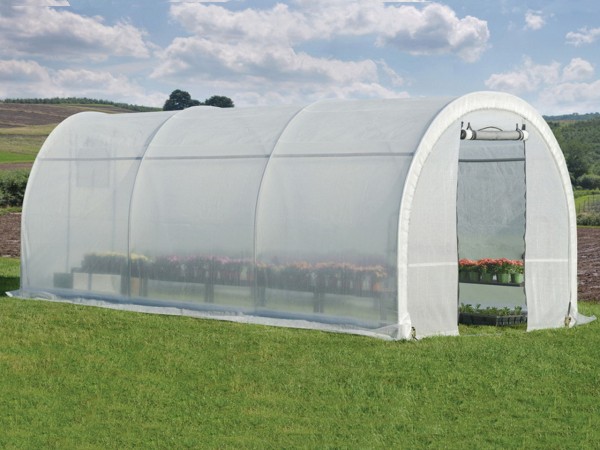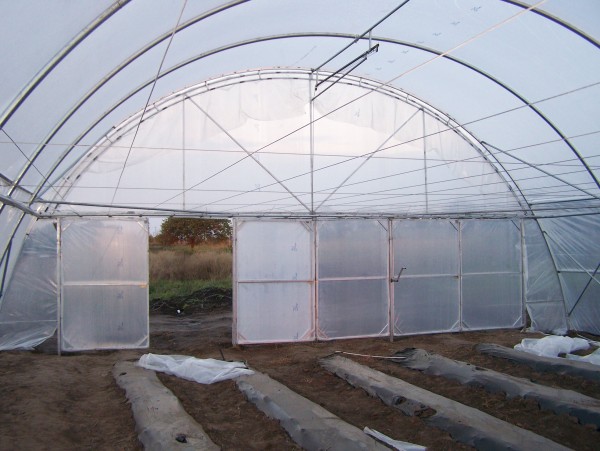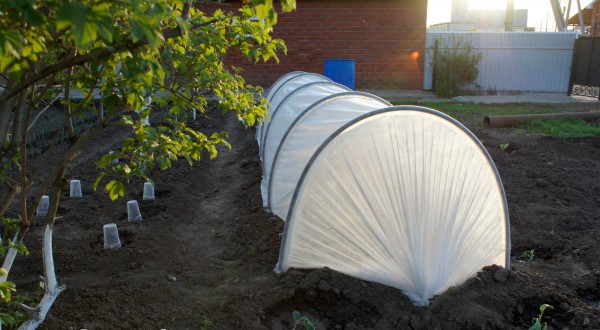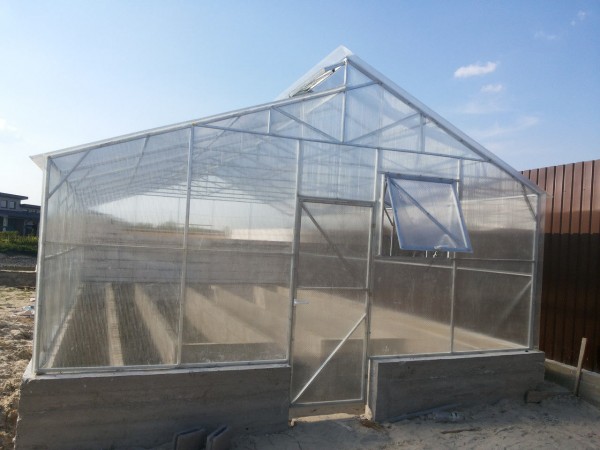How to choose and use agrofibre for a greenhouse correctly
Content
Material description
More than 10 years ago, people learned how to make agrofiber - a nonwoven polymer material produced using spunbond technology. It is often called that. It is used in construction, medicine, agriculture, clothing and packaging. This widespread use is due to the relative cheapness of production, as well as the remarkable properties of agrofibre.
The fine structure makes it look like an ordinary canvas, it is very light and durable, it transmits light, water and air, does not rot, does not grow moldy, and is not toxic. Spunbond is indifferent to the effects of acids, alkalis, low or high temperatures. Such qualities are best suited for sheltering vegetable crops from cold weather; farmers of European countries have long used this.

Agrofibre is so light that it is not necessary for it to build a frame, it is simply laid on the beds, pressing it with earth or pegs along the edges - even the most fragile plant will support its weight. Spunbond can be left on the seedlings for a long time, unlike the film, which will have to be removed and laid all the time (and it is better to pull it over the frame, because its weight will break the plants). You can simply water from above - the material will perfectly allow moisture, light and air to reach the plant.
It will have to be removed periodically only for weeding. And if you use several types of the same polymer material, you can even achieve that the weeds will not grow in the aisles. Agrofibre is sold in large rolls. The most common width: 1.6 m or 3.2 m. Rolls can contain material from 10 m to 1500 m, which compares favorably with polyethylene film, which is difficult to find in large widths.
Video"The use of agrofibre for covering greenhouses and greenhouses"
Description of ways to use agrofibre to cover various types of greenhouses
Types of agrofibre
Different types of agrofibre are used in different ways in the garden and in the garden. They can protect plants from wind, hail, rainfall, cold, birds or insects, shade from direct sunlight, both tender seedlings and young trees or bushes. It is also successfully used for soil mulching.

Spunbond can be black and white, in addition to color, it differs in density. White is used as a covering material for greenhouses, greenhouses, just beds instead of film. It is easy to work with him, therefore, it is from him that greenhouses are made with their own hands. Black, which has a mulching effect, successfully removes weeds from the beds. The most common density is 50-60 g / m2, it does not transmit light, which means that nothing grows under it. It is often used in this way: cut in the right places, spread it on the garden bed, sow or plant plants in the slots.
The canvas perfectly permeates water, retains heat, but without light, nothing grows under it - a wonderful way to get rid of constant weeding. This is how strawberries and strawberries are often grown - they ripen earlier, and the berries do not come into contact with the ground.
White agricultural canvas is produced in different densities, from 15 g / m2 to 120 g / m2.Thin, with a density of 15 g / m2, 17 g / m2, 23 g / m2 is usually used for growing early greens or vegetables. They cover vegetation in the beds or inside greenhouses (they arrange mini-greenhouses) from frost to -4o, from snow, rain or hail, sunburn, pests.

With a canvas with a density of 30 g / m2, in addition to the beds, you can still cover trees and shrubs from frost to -6o, or you can use it to make greenhouses. To make a greenhouse with your own hands, it is better to take not a film, but an agricultural canvas with a density of 42 g / m2 or even 55 g / m2. It is able to maintain a comfortable temperature inside during frost up to 10 degrees; in case of severe frosts, it is recommended to make another covering layer from a less dense agricultural canvas. It does not collect condensation, unlike film, it transmits sunlight and air better.
Another indisputable plus of its operation is durability. If you cover a bed with seedlings with a film, remove it for watering, airing, weeding, then lay it again, it will last for 1 season, and the polymer cloth does not need to be removed so often, after use it is dried and stored in a dark, dry room away from rodents. Thus, it can run for at least 3 seasons.
Cellular polycarbonate
Cellular polycarbonate is a modern plastic with a honeycomb structure. It is durable, resistant to aggressive environments, incredibly light due to its cellular structure, produced by the manufacturer in sheets of various colors. Like a thin spunbond, it can transmit 90% of the light. Manufacturers produce products of different light transmittance: from transparent to tinted in different shades. It is produced separately for indoor and outdoor use, so for outdoor use, the sheets are covered on both sides with a film that is impervious to ultraviolet rays.

Polycarbonate does not burn, is indifferent to most chemicals, resists mechanical stress at any temperature, perfectly conserves heat. A polycarbonate roof cannot be pierced by the largest hail. And if you manage to break it, it will not shatter into fragments like glass. In addition, it has flexibility without heating (you can simply bend it with an arc with your hands), a small mass, and sound insulation. These qualities made it very popular in construction.
How is it used
Cellular polycarbonate was launched into wide industrial production in 1960. He immediately gained immense popularity in medicine, design, and construction. Craftsmen loved to work with him with their own hands, so he quickly became a popular building material in summer cottages. This straight, solid material bends easily at any temperature, so semicircular hangars, canopies over doors or balconies, greenhouses and greenhouses made of agrofibre are often made from it.
Transparent roofs, awnings, suspended ceilings with diffused light, lighting fixtures, partitions, fences, pools, doors are made of it. Polycarbonate is widely used in agriculture. Winter gardens, greenhouses and greenhouses have recently been made from it, and the owners often make them with their own hands.

Greenhouses made of polycarbonate summer residents use stationary on a foundation for growing plants all year round, make lightweight portable without a foundation in order to close the seedlings for a short time. You can buy them, but many people prefer to make them with their own hands. Thanks to the happy combination of its qualities, polycarbonate has become the golden mean between film and glass.
Video"Stretching agrofibre in the greenhouse"
The process of using agrofibre correctly in a greenhouse to shelter young seedlings
